Effect of Electric Current Heat Treatment on Commercially Pure Titanium Sheets
Abstract
:1. Introduction
2. Experimental Procedure
3. Results and Discussion
3.1. Electric Current Treatment
3.2. Microstructure Evolution
3.3. Texture Evolution
3.4. Effect of Electric Current Treatment on Recrystallization Behavior
3.5. Effect of Electric Current Treatment on Mechanical Properties
3.6. Effect of Electric Current Treatment on Sheet Shape and Oxidation
4. Conclusions
- (i)
- The electric current treatment results in the development of finer microstructure with relatively weak texture as compared to the conventional heat treated sample due to the difference in recrystallization behavior.
- (ii)
- In the case of electric current heat treatment, the smaller recrystallized grains nucleated near the shear bands and deformation twins with relatively random orientations. Besides, recrystallization in the conventional heat treatment is occurred by the sub-grain boundary migration within the elongated grains during heating and has a similar orientation as their parent grains with relatively larger grain size.
- (iii)
- Due to the refined grain morphology with weak texture intensity, the room-temperature tensile properties of the electric current treatment samples were superior to those of the conventional heat-treated specimens.
- (iv)
- The degree of distortion and the oxidation resistance of electric heat-treated samples was significantly improved as compared with the conventional heat-treated ones due to the rapid processing time.
Author Contributions
Funding
Institutional Review Board Statement
Informed Consent Statement
Data Availability Statement
Acknowledgments
Conflicts of Interest
References
- Gerd, L.; Williams James, C. Titanium; Springer: Berlin/Heidelberg, Germany, 2003; pp. 149–175. [Google Scholar]
- Lütjering, G.; Williams, J.C. Commercially Pure (CP) Titanium and Alpha Alloys. In Titanium; Springer: Berlin/Heidelberg, Germany, 2007; pp. 175–201. [Google Scholar]
- Zherebtsov, S.V.; Dyakonov, G.S.; Salem, A.A.; Sokolenko, V.I.; Salishchev, G.A.; Semiatin, S.L. Formation of nanostructures in commercial-purity titanium via cryorolling. Acta Mater. 2013, 61, 1167–1178. [Google Scholar] [CrossRef]
- Won, J.W.; Lee, J.H.; Jeong, J.S.; Choi, S.W.; Lee, D.J.; Hong, J.K.; Hyun, Y.T. High strength and ductility of pure titanium via twin-structure control using cryogenic deformation. Mater. Sci. Eng. A 2020, 178, 94–98. [Google Scholar] [CrossRef]
- Won, J.W.; Lee, S.; Park, S.H.; Kang, M.; Lim, K.R.; Park, C.H.; Na, Y.S. Ultrafine-grained CoCrFeMnNi high-entropy alloy produced by cryogenic multi-pass caliber rolling. J. Alloys Compd. 2018, 742, 290–295. [Google Scholar] [CrossRef]
- Chausov, M.G.; Maruschak, P.O.; Hutsaylyuk, V.; Sniezek, L.; Pylypenko, A.P. Effect of complex combined loading mode on the fracture toughness of titanium alloys. Vacuum 2018, 147, 51–57. [Google Scholar] [CrossRef]
- Chausov, M.; Maruschak, P.; Pylypenko, A.; Markashova, L. Enhancing plasticity of high-strength titanium alloys VT 22 under impact-oscillatory loading. Philos. Mag. 2017, 97, 389–399. [Google Scholar] [CrossRef]
- Kameyama, T.; Matsunaga, T.; Sato, E.; Kuribayashi, K. Suppression of ambient-temperature creep in CP-Ti by cold-rolling. Mater. Sci. Eng. A 2009, 510–511, 364–367. [Google Scholar] [CrossRef]
- Alkhazraji, H.; Salih, M.Z.; Zhong, Z.; Mhaede, M.; Brokmeier, H.-G.; Wagner, L.; Schell, N. Estimation of Dislocation Density in Cold-Rolled Commercially Pure Titanium by Using Synchrotron Diffraction. Metall. Mater. Trans. B 2014, 45, 1557–1564. [Google Scholar] [CrossRef]
- Kim, W.J.; Yoo, S.J.; Lee, J.B. Microstructure and mechanical properties of pure Ti processed by high-ratio differential speed rolling at room temperature. Scr. Mater. 2010, 62, 451–454. [Google Scholar] [CrossRef]
- Dyakonov, G.S.; Zherebtsov, S.V.; Klimova, M.V.; Salishchev, G.A. Microstructure evolution of commercial-purity titanium during cryorolling. Phys. Met. Metallogr. 2015, 116, 182–188. [Google Scholar] [CrossRef]
- Stolyarov, V.V.; Zhu, Y.T.; Alexandrov, I.V.; Lowe, T.C.; Valiev, R.Z. Influence of ECAP routes on the microstructure and properties of pure Ti. Mater. Sci. Eng. A 2001, 299, 59–67. [Google Scholar] [CrossRef]
- Ko, Y.G.; Shin, D.H.; Park, K.-T.; Lee, C.S. An analysis of the strain hardening behavior of ultra-fine grain pure titanium. Scr. Mater. 2006, 54, 1785–1789. [Google Scholar] [CrossRef]
- Fattah-alhosseini, A.; Keshavarz, M.K.; Mazaheri, Y.; Reza, A. Strengthening mechanisms of nano-grained commercial pure titanium processed by accumulative roll bonding. Mater. Sci. Eng. A 2017, 693, 164–169. [Google Scholar] [CrossRef]
- Sergueeva, A.V.; Stolyarov, V.V.; Valiev, R.Z.; Mukherjee, A.K. Advanced mechanical properties of pure titanium with ultrafine grained structure. Scr. Mater. 2001, 45, 747–752. [Google Scholar] [CrossRef]
- Choi, S.-W.; Li, C.-L.; Won, J.W.; Yeom, J.-T.; Choi, Y.S.; Hong, J.-K. Deformation heterogeneity and its effect on recrystallization behavior in commercially pure titanium: Comparative study on initial microstructures. Mater. Sci. Eng. A 2019, 764, 138211. [Google Scholar] [CrossRef]
- Won, J.W.; Park, C.H.; Hong, J.; Lee, C.S.; Hong, S.G. Simultaneous Improvement in the Strength and Formability of Commercially Pure Titanium via Twinning-induced Crystallographic Texture Control. Sci. Rep. 2019, 9, 2009. [Google Scholar] [CrossRef]
- Hamada, S.; Noguchi, H. Fatigue characteristics of a notched specimen made of commercially pure titanium. Theor. Appl. Fract. Mech. 2020, 109, 102764. [Google Scholar] [CrossRef]
- Li, X.; Sun, B.-H.; Guan, B.; Jia, Y.-F.; Gong, C.-Y.; Zhang, X.-C.; Tu, S.-T. Elucidating the effect of gradient structure on strengthening mechanisms and fatigue behavior of pure titanium. Int. J. Fatigue 2021, 146, 106142. [Google Scholar] [CrossRef]
- Catherine, L.; Hamid, D.C.A. The effect of heat treatment on the tensile strength and ductility of pure titanium grade 2. IOP Conf. Ser. Mater. Sci. Eng. 2018, 429, 012014. [Google Scholar] [CrossRef]
- Hoseini, M.; Pourian, M.H.; Bridier, F.; Vali, H.; Szpunar, J.A.; Bocher, P. Thermal stability and annealing behaviour of ultrafine grained commercially pure titanium. Mater. Sci. Eng. A 2012, 532, 58–63. [Google Scholar] [CrossRef]
- Shin, K.R.; Ko, Y.G.; Shin, D.H. Effect of electrolyte on surface properties of pure titanium coated by plasma electrolytic oxidation. J. Alloys Compd. 2021, 509, S478–S481. [Google Scholar] [CrossRef]
- Leopold, K.; Anatoly, B.; Andreas, C.; En, T.C. Effect of Pulsed Electric Current Treatment on the Corrosion and Strength of Reinforcing Steel. Mater. Sci. Forum 2012, 706–709, 937–944. [Google Scholar]
- Roh, J.-H.; Seo, J.-J.; Hong, S.-T.; Kim, M.-J.; Han, H.N.; Roth, J.T. The mechanical behavior of 5052-H32 aluminum alloys under a pulsed electric current. Int. J. Plast. 2014, 58, 84–99. [Google Scholar] [CrossRef]
- Park, J.-W.; Jeong, H.-J.; Jin, S.-W.; Kim, M.-J.; Lee, K.; Kim, J.J.; Hong, S.-T.; Han, H.N. Effect of electric current on recrystallization kinetics in interstitial free steel and AZ31 magnesium alloy. Mater. Charact. 2017, 133, 70–76. [Google Scholar] [CrossRef]
- Yang, C.; Lim, J.A.; Ding, Y.F.; Zhang, W.W.; Li, Y.Y.; Fu, Z.Q.; Chan, F.; Lavernia, E.J. Texture evolution and mechanical behavior of commercially pure Ti processed via pulsed electric current treatment. J. Mater. Sci. 2016, 51, 10608–10619. [Google Scholar] [CrossRef]
- Zhao, Z.; Wang, G.; Zhang, Y.; Wang, Y.; Hou, H. Fast recrystallization and phase transformation in ECAP deformed Ti–6Al–4V alloy induced by pulsed electric current. J. Alloys Compd. 2019, 786, 733–741. [Google Scholar] [CrossRef]
- Dinh, K.-A.; Hong, S.-T.; Choi, S.-J.; Kim, M.-J.; Kim, H.N. The Effect of Pre-strain and Subsequent Electrically Assisted Annealing on the Mechanical Behaviors of Two Different Aluminum Alloys. Int. J. Precis. Eng. Manuf. 2020, 21, 2345–2358. [Google Scholar] [CrossRef]
- Konovalov, S.; Komissarova, I.; Ivanov, Y.; Gromov, V.; Kosinov, D. Structural and phase changes under electropulse treatment of fatigue-loaded titanium alloy VT1-0. J. Mater. Res. Technol. 2019, 8, 1300–1307. [Google Scholar] [CrossRef]
- Wang, Z.J.; Song, H. Effect of high-density electropulsing on microstructure and mechanical properties of cold-rolled TA15 titanium alloy sheet. J. Alloys Compd. 2009, 470, 522–530. [Google Scholar] [CrossRef]
- Lee, T.; Magargee, J.; Ng, M.K.; Cao, J. Constitutive analysis of electrically-assisted tensile deformation of CP-Ti based on non-uniform thermal expansion, plastic softening and dynamic strain aging. Int. J. Plast. 2017, 94, 44–56. [Google Scholar] [CrossRef]
- Guan, L.; Tang, G.; Jiang, Y.; Chu, P.K. Texture evolution in cold-rolled AZ31 magnesium alloy during electropulsing treatment. J. Alloys Compd. 2009, 487, 309–313. [Google Scholar] [CrossRef]
- Kim, J.H.; Suh, B.-C.; Trang, T.T.T.; Hwang, J.H.; Kim, N.J. Orientations of dynamically recrystallized grains nucleated at double twins in Mg-4Zn-1Sn alloy. Scr. Mater. 2019, 170, 11. [Google Scholar] [CrossRef]
- Bozzolo, N.; Dewobroto, N.; Grosdidier, T.; Wagner, F. Texture evolution during grain growth in recrystallized commercially pure titanium. Mater. Sci. Eng. A 2005, 397, 346–355. [Google Scholar] [CrossRef]
- Ion, S.E.; Humphreys, F.J.; White, S.H. Dynamic recrystallisation and the development of microstructure during the high temperature deformation of magnesium. Acta Mater. 1982, 30, 1909–1919. [Google Scholar] [CrossRef]
- Zhu, K.Y.; Chaubet, D.; Bacroix, B.; Brisset, F. A study of recovery and primary recrystallization mechanisms in a Zr–2Hf alloy. Acta Mater. 2005, 53, 5131–5140. [Google Scholar] [CrossRef]
- Robson, J.D.; Henry, D.T.; Davis, B. Particle effects on recrystallization in magnesium–manganese alloys: Particle-stimulated nucleation. Acta Mater. 2009, 57, 2739–2747. [Google Scholar] [CrossRef]
- Sandlöbes, S.; Zaefferer, S.; Schestakow, I.; Yi, S.; Gonzalez-Martinez, R. On the role of non-basal deformation mechanisms for the ductility of Mg and Mg–Y alloys. Acta Mater. 2011, 59, 429–439. [Google Scholar] [CrossRef] [Green Version]
- Kim, Y.M.; Mendis, C.; Sasaki, T.; Letzig, D.; Pyczak, F.; Hono, K.; Yi, S. Static recrystallization behaviour of cold rolled Mg-Zn-Y alloy and role of solute segregation in microstructure evolution. Scr. Mater. 2017, 136, 41–45. [Google Scholar] [CrossRef] [Green Version]
- Basu, I.; Al-Samman, T.; Gottstein, G. Shear band-related recrystallization and grain growth in two rolled magnesium-rare earth alloys. Mater. Sci. Eng. A 2013, 579, 50–56. [Google Scholar] [CrossRef]
- Li, X.; Yang, P.; Wang, L.N.; Meng, L.; Cui, F.E. Orientational analysis of static recrystallization at compression twins in a magnesium alloy AZ31. Mater. Sci. Eng. A 2009, 517, 160–169. [Google Scholar] [CrossRef]
- Farzadfar, S.A.; Martin, E.; Sanjari, M.; Essadiqi, E.; Yue, S. Texture weakening and static recrystallization in rolled Mg–2.9 Y and Mg–2.9 Zn solid solution alloys. J. Mater. Sci. 2012, 47, 5488–5500. [Google Scholar] [CrossRef]
- Kim, N.J. Critical Assessment 6: Magnesium sheet alloys: Viable alternatives to steels? Mater. Sci. Technol. 2014, 30, 1925–1928. [Google Scholar] [CrossRef]
- Agnew, S.R.; Yoo, M.H.; Tome, C.N. Application of texture simulation to understanding mechanical behavior of Mg and solid solution alloys containing Li or Y. Acta Mater. 2001, 49, 4277–4289. [Google Scholar] [CrossRef]
- Hantzsche, K.; Bohlen, J.; Wendt, J.; Kainer, K.U.; Yi, S.B.; Letzig, D. Effect of rare earth additions on microstructure and texture development of magnesium alloy sheets. Scr. Mater. 2010, 63, 725–730. [Google Scholar] [CrossRef]
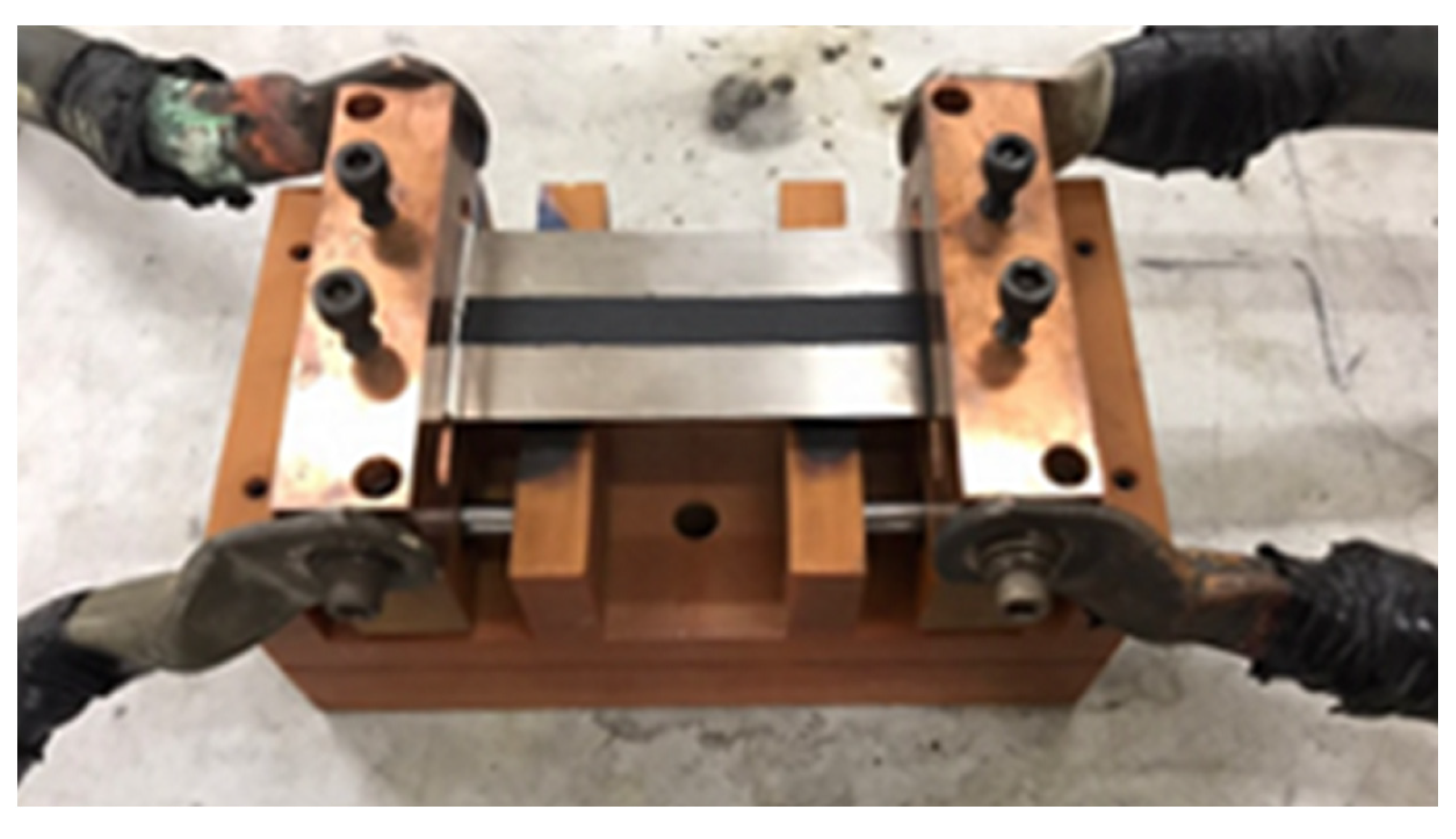
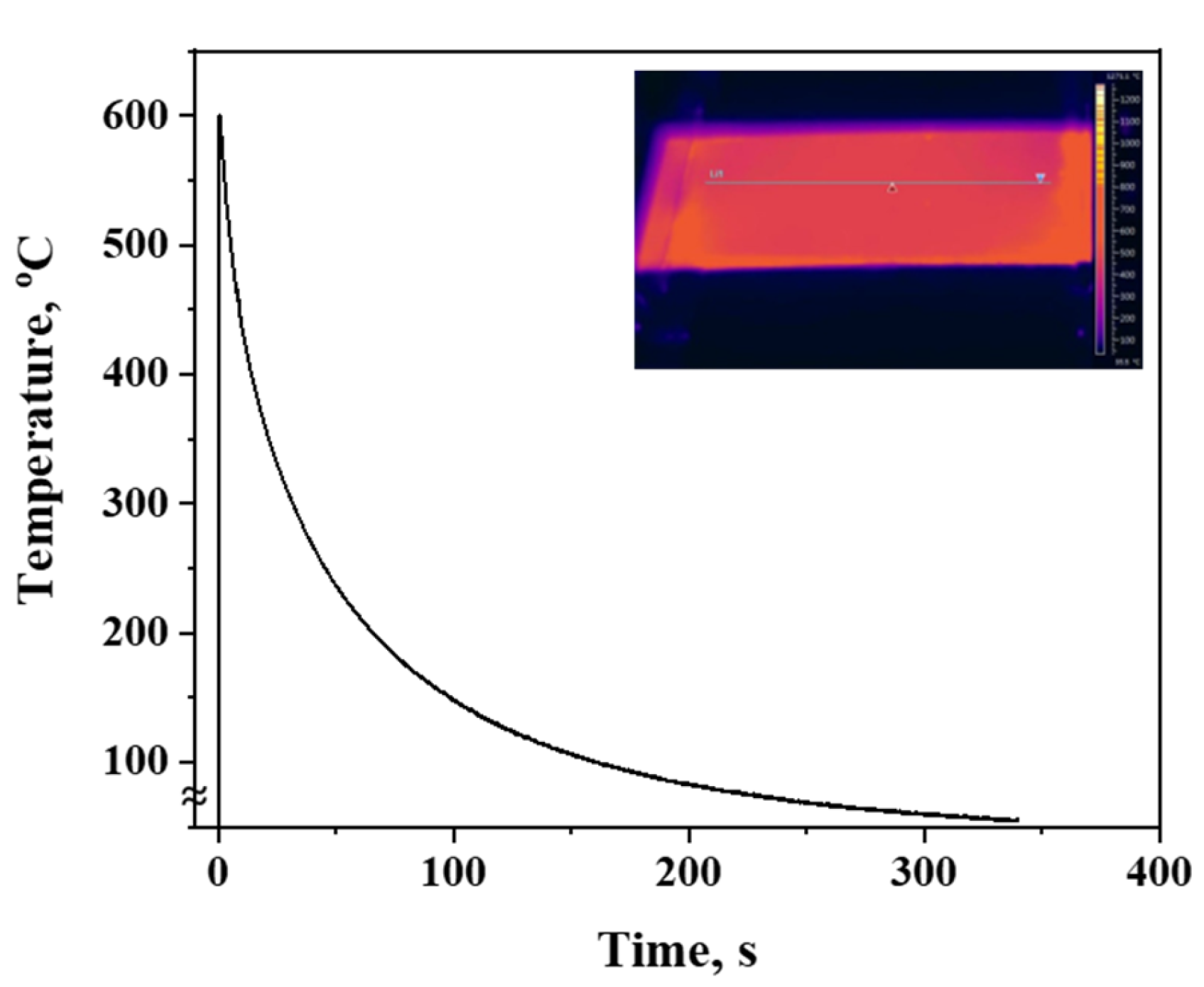




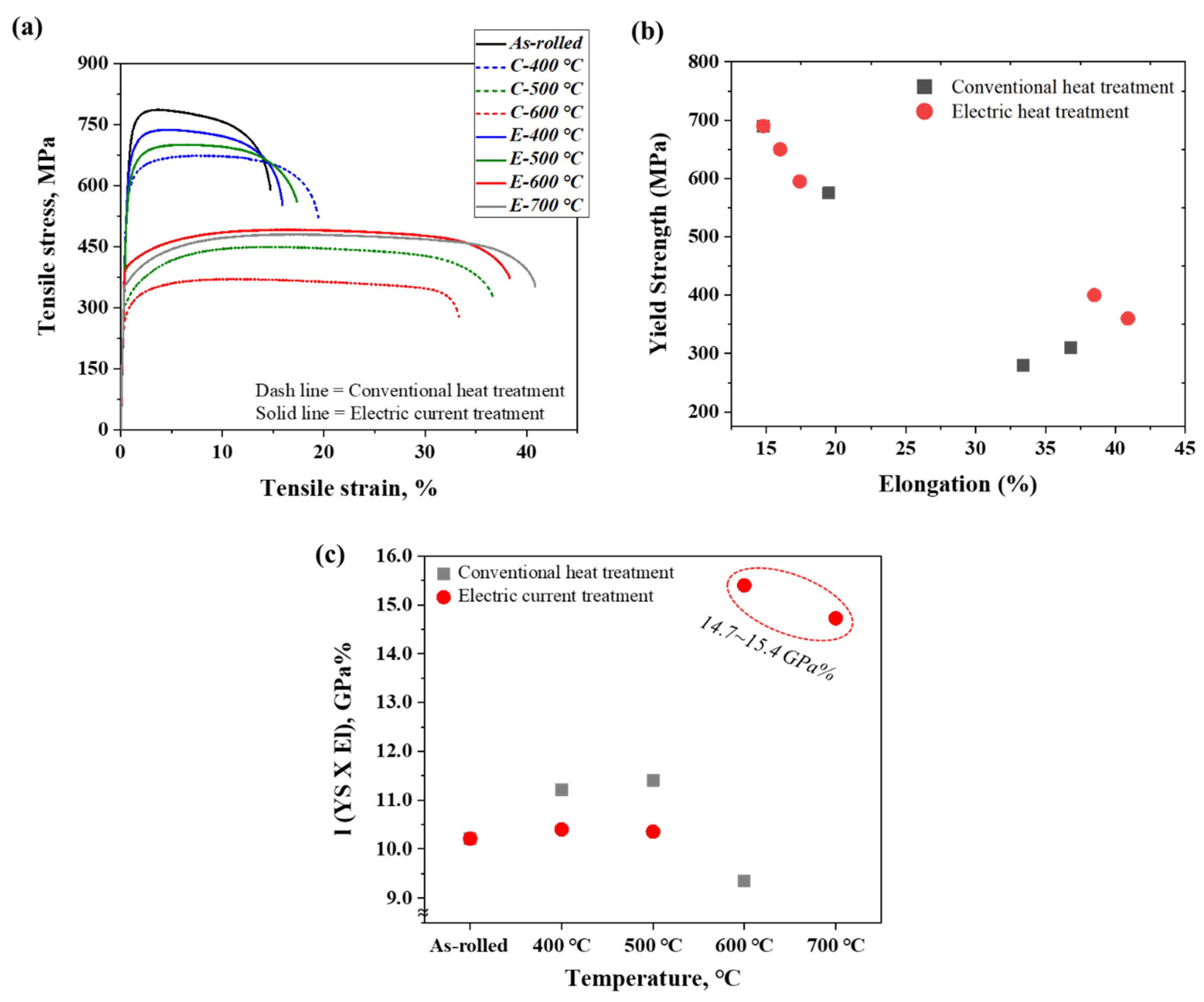
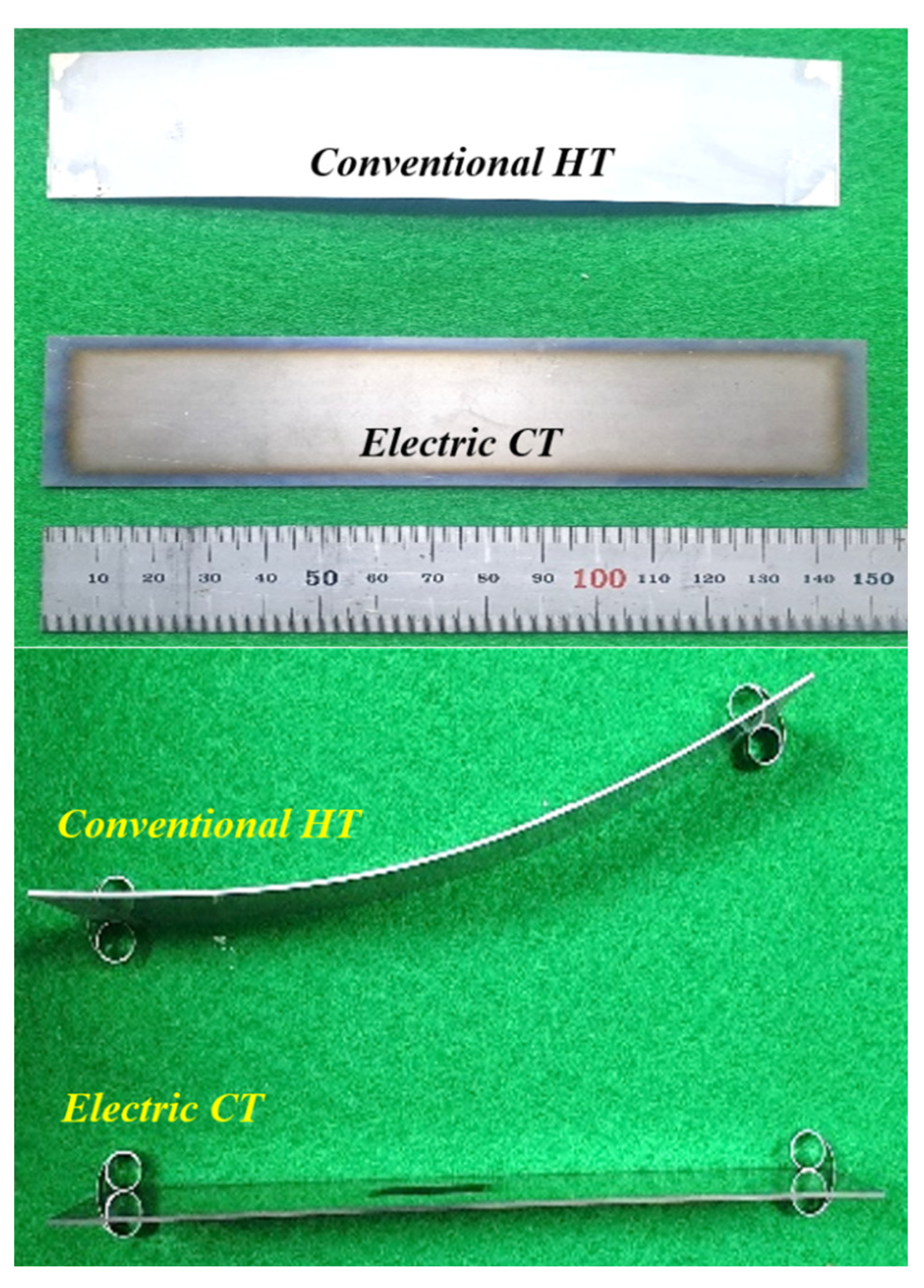
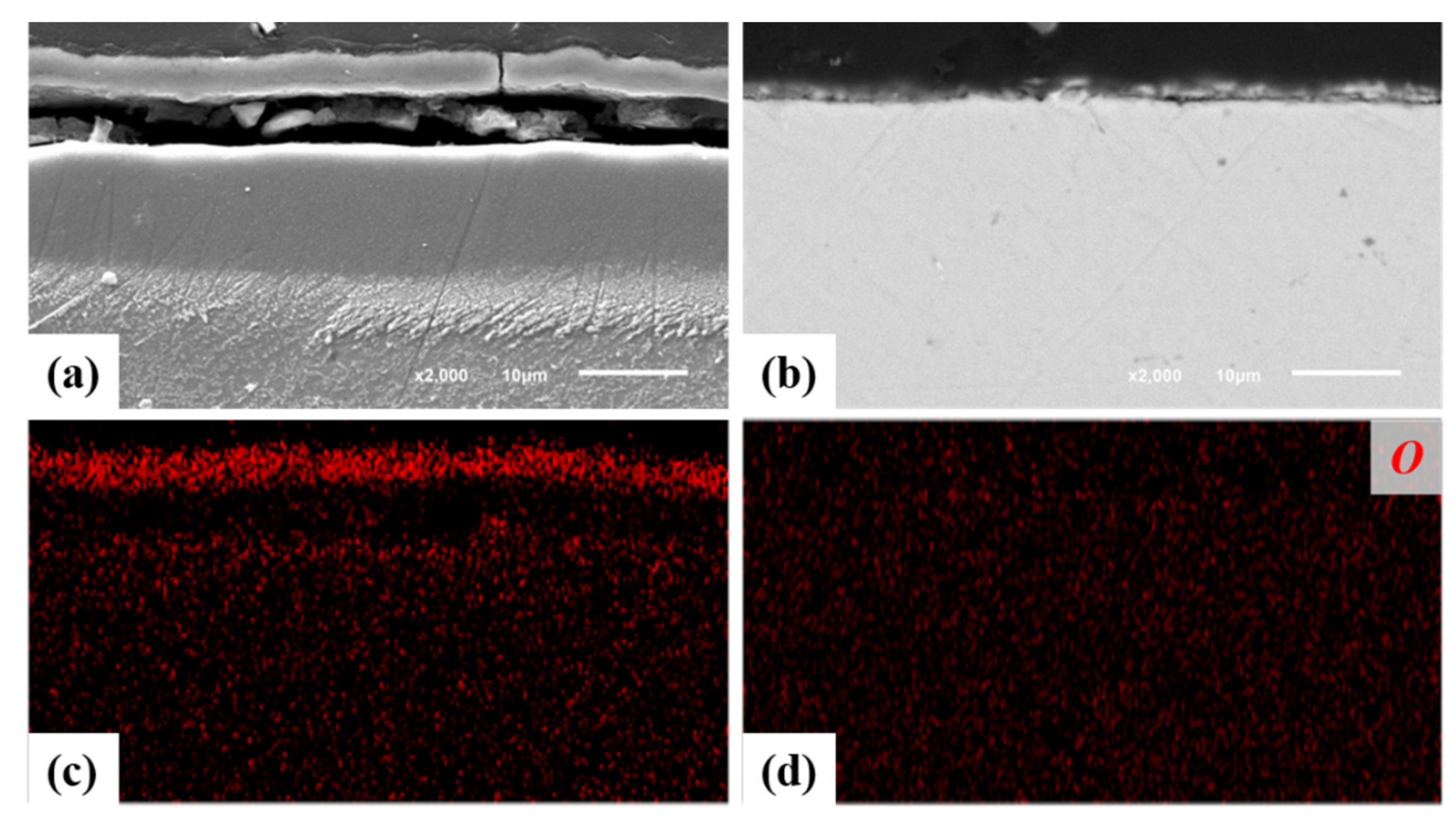
| Case | Current density (A/mm2) | I (kA) | Duration (s) | Temperature (°C) |
|---|---|---|---|---|
| 1 | 56 | 2.25 | 0.5 | 400 |
| 2 | 60.5 | 2.42 | 500 | |
| 3 | 66 | 2.64 | 600 | |
| 4 | 71 | 2.85 | 700 |
Publisher’s Note: MDPI stays neutral with regard to jurisdictional claims in published maps and institutional affiliations. |
© 2021 by the authors. Licensee MDPI, Basel, Switzerland. This article is an open access article distributed under the terms and conditions of the Creative Commons Attribution (CC BY) license (https://creativecommons.org/licenses/by/4.0/).
Share and Cite
Lee, C.H.; Choi, S.-W.; Narayana, P.L.; Nguyet Nguyen, T.A.; Hong, S.-T.; Kim, J.H.; Kang, N.; Hong, J.-K. Effect of Electric Current Heat Treatment on Commercially Pure Titanium Sheets. Metals 2021, 11, 783. https://doi.org/10.3390/met11050783
Lee CH, Choi S-W, Narayana PL, Nguyet Nguyen TA, Hong S-T, Kim JH, Kang N, Hong J-K. Effect of Electric Current Heat Treatment on Commercially Pure Titanium Sheets. Metals. 2021; 11(5):783. https://doi.org/10.3390/met11050783
Chicago/Turabian StyleLee, Chan Hyeok, Seong-Woo Choi, P. L. Narayana, Thi Anh Nguyet Nguyen, Sung-Tae Hong, Jae H. Kim, Namhyun Kang, and Jae-Keun Hong. 2021. "Effect of Electric Current Heat Treatment on Commercially Pure Titanium Sheets" Metals 11, no. 5: 783. https://doi.org/10.3390/met11050783







